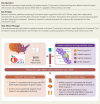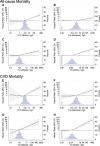High-sensitivity troponins and mortality in the general population
- PMID: 37264651
- PMCID: PMC10361011
- DOI: 10.1093/eurheartj/ehad328
High-sensitivity troponins and mortality in the general population
Abstract
Aims: Cardiac troponin T and I can be measured using a number of high-sensitivity (hs) assays. This study aimed to characterize correlations between four such assays and test their comparative associations with mortality.
Methods and results: Among adults without cardiovascular disease in the 1999-2004 National Health and Nutrition Examination Survey, hs-troponin T was measured using one assay (Roche) and hs-troponin I using three assays (Abbott, Siemens, and Ortho). Cox regression was used to estimate associations with all-cause and cardiovascular mortality. Pearson's correlation coefficients comparing concentrations from each assay ranged from 0.53 to 0.77. There were 2188 deaths (488 cardiovascular) among 9810 participants. Each hs-troponin assay [log-transformed, per 1 standard deviation (SD)] was independently associated with all-cause mortality: hazard ratio (HR) 1.20 [95% confidence interval (CI) 1.13-1.28] for Abbott hs-troponin I; HR 1.10 (95% CI 1.02-1.18) for Siemens hs-troponin I; HR 1.23 (95% CI 1.14-1.33) for Ortho hs-troponin I; and HR 1.31 (95% CI 1.21-1.42) for Roche hs-troponin T. Each hs-troponin assay was also independently associated with cardiovascular mortality (HR 1.44 to 1.65 per 1 SD). Associations of hs-troponin T and all-cause and cardiovascular mortality remained significant after adjusting for hs-troponin I. Furthermore, associations of hs-troponin I remained significant after mutually adjusting for hs-troponin I from the other individual assays: e.g. cardiovascular mortality HR 1.46 (95% CI 1.19-1.79) for Abbott after adjustment for the Siemens assay and HR 1.29 (95% CI 1.09-1.53) for Abbott after adjustment for the Ortho assay.
Conclusion: This study demonstrates only modest correlations between hs-troponin T and three hs-troponin I assays and that hs-troponin I assays can provide distinct risk information for mortality in the general population.
Keywords: All-cause mortality; Cardiovascular mortality; High-sensitivity cardiac troponin; NHANES.
© The Author(s) 2023. Published by Oxford University Press on behalf of the European Society of Cardiology.
Conflict of interest statement
Conflict of interest R.H.C. has received grant support from Roche Diagnostics, Fujirebio Diagnostics, Beckman Coulter, Siemens Healthcare Diagnostics, Ortho Clinical Diagnostics, Becton Dickinson, Abbott Diagnostics, Mitsubishi, and Horiba Medical and has consulting agreements with PixCell, Beckman Coulter, Quidel, Siemens Healthineers, and Roche Diagnostics. The other authors report no conflicts of interest relevant to this article.
Figures



Comment in
-
Comparisons of multiple troponin assays for detecting chronic myocardial injury in the general population: redundant or complementary?Eur Heart J. 2023 Jul 21;44(28):2606-2608. doi: 10.1093/eurheartj/ehad414. Eur Heart J. 2023. PMID: 37387309 No abstract available.

